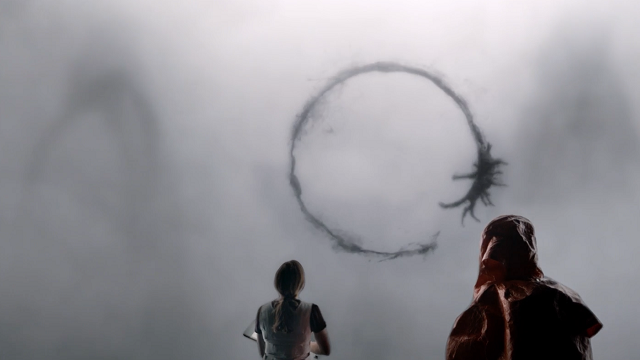Within the first five minutes of Arrival, Louise (Amy Adams) gives away the twist of the movie while sad cellos mourn the death of Louise’s cancer-ridden palindromically-named daughter, Hannah. As her blue-filtered daughter dies a typically-tragic hospital death, Louise tells the audience that she has lost track of time and doesn’t know whether the beginning is the end, the end is the beginning or where the middle of the story is. By the time this storytelling device bears any actual fruit, its importance has all but rotted away. For two acts, Hannah’s story is little more than an unearned emotional spice in the background of Louise’s meeting with a newly-landed group of aliens.
A fleet of 12 gigantic spacecraft have landed on Earth in 12 random spaces scattered around the planet. These mammoth towers float a handful of feet above the land, and periodically open a hatch inviting humanity to come and investigate the spaceship and its inhabitants through a viewing platform similar to those found in an aquarium. Due to a language barrier, the aliens – giant heptopods resembling a marriage of The Addams’ Thing and an octopus – are unable to communicate their purpose, and the various governments are unable to understand the aliens. That’s where Louise, a linguistics professor comes in.
Louise is recruited by the government – led by Colonel Forest Whitaker delivering a Species-level performance – to communicate with the aliens through language while theoretical physicist Ian (Jeremy Renner) tries to use science. Louise spends her time teaching the aliens the building blocks of English. In turn, the aliens teach Louise the construction of their language, a bunch of elaborate Rorschach-esque smoke rings with no beginning, middle, or end. Other countries seem to be communicating through other avenues – apparently the Chinese try to communicate through Mahjong, which is neither the first nor the worst of Arrival‘s ridiculously unformed ideas – yet the development of communication is a race to see which country loses patience first.
Arrival is an utterly humorless super serious mashup of Kurt Vonnegut’s greatest hits and Carl Sagan’s Contact. Director Denis Villeneuve (Prisoners, Enemy) and screenwriter Eric Heisserer (Lights Out, Final Destination 5), have many things to say but their ideas, to be discussed in a different essay, are ultimately underdeveloped and naive. Every plot development is beknighted with weighty portent that ultimately fizzles under a fit of giggles. Every deep thought crumbles with a minuscule amount of reflection. Villeneuve is a director who traffics in unearned emotional impact without wondering what the underlying messages actually contain.
Like Christopher Nolan with Interstellar, Villeneuve is bringing his limited cinematic imagination to the science fiction genre. He sets the grand meeting of an alien species in the middle of summer-green Montana, but relies on a blue-grey filter to add somberness that he can’t achieve with framing alone. A shot up the side of space ship is meant to evoke a Kubrickian immensity, but he cuts it short without having a sky for scale. Johann Johannson’s score is depressing to the point of oppression. Villeneuve crushes what could have been a thoughtful experience under the same weight he gave to Prisoners, a movie contemplating the gravity of torture.
Ultimately, Arrival is a compelling experiment flattened by Villeneuve’s typically heavy-handed execution. The movie almost works in the moment – it’s rarely dull – but the premise is so undermined by its overly earnest finale that the overall effect is like eating too much candy during Halloween. It’s tasty as it is being consumed, but tends to leave the viewer a bit nauseous.

